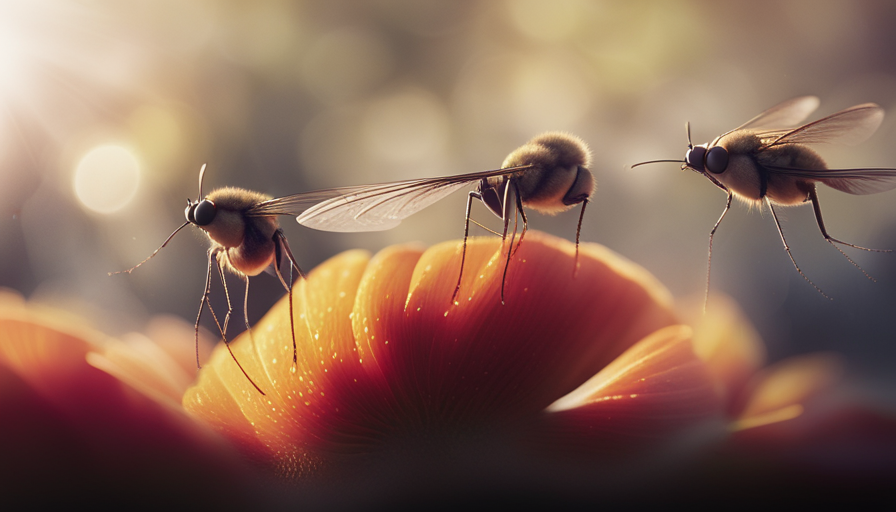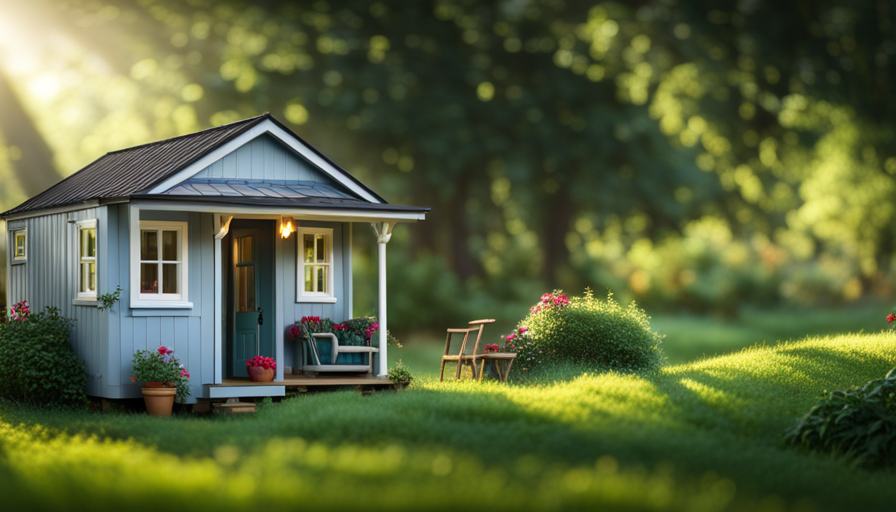Have you ever been lounging in your living room, having a peaceful moment to yourself, when suddenly a swarm of tiny gnats appear out of thin air and start flying around you? It can be quite annoying and frustrating, a common issue that many homeowners have faced at some point. You may find it helpful to learn more about **how to get rid of these pesky pests** to make your home a more pleasant place to be.
But what exactly are these pesky insects, and why do they seem to have taken up residence in your house?
Well, let me shed some light on the subject. Gnats are small flying insects that belong to the family of flies. They are commonly found in homes and can be a real nuisance. There are several types of gnats that may infest your house, including fruit flies, fungus gnats, and drain flies.
The causes of gnat infestations can vary, but they are often attracted to areas with moisture and decaying organic matter. This could include overripe fruits, damp soil, or even clogged drains. However, there are steps you can take to prevent and eliminate these tiny pests from your home.
In this article, I will provide you with some valuable information on the types of gnats found in homes, common causes of infestations, prevention tips, and natural remedies to get rid of them. I will also discuss chemical solutions and how to identify and eliminate gnat breeding sites.
Additionally, I will touch on the health concerns related to gnats and when it may be necessary to seek professional help for persistent infestations.
So, if you’re tired of dealing with these tiny gnats in your house, keep reading to find out how to regain control of your home and bid farewell to these unwelcome guests.
Key Takeaways
- Gnats are attracted to moisture and decaying organic matter, so it’s important to keep the house clean and dry to prevent infestations.
- Proper plant care, including allowing soil to dry between waterings, can help prevent gnat infestations caused by indoor plants.
- Natural gnat repellents such as citronella candles, essential oils, and vinegar traps can be effective in controlling and eliminating gnats.
- If gnat infestations persist or are severe, it is recommended to seek professional pest control services for accurate identification and tailored solutions.
Types of Gnats Found in Homes
You’ll often find those pesky little gnats buzzing around your house, from the fruit flies that hover near your overripe bananas to the fungus gnats flitting around your damp houseplants.
Gnats in food can be a frustrating problem, as they contaminate your kitchen and can even make you sick. Fruit flies are attracted to rotting fruits and vegetables, while fungus gnats thrive in moist soil.
To prevent gnat infestations, it’s crucial to store your produce properly and dispose of any spoiled items promptly. Keep your kitchen clean and free of crumbs, and regularly empty your garbage bins. Additionally, ensure that your houseplants are not overwatered and that excess moisture is drained away.
By eliminating their preferred breeding grounds, you can greatly reduce the number of gnats in your home. It’s important to take these preventative measures because gnat infestations can be caused by common factors such as poor sanitation and excessive moisture.
Common Causes of Gnat Infestations
In my experience, the common causes of gnat infestations in homes often revolve around three key points:
-
Overripe fruits and vegetables attract gnats due to the sweet scent emitted by rotting produce. This makes overripe fruits and vegetables a prime breeding ground for these tiny pests.
-
Moisture and damp areas provide ideal conditions for gnats to thrive. They are attracted to moist and damp environments, such as leaky faucets or areas with poor ventilation.
-
Indoor plants can also contribute to gnat infestations. The damp soil in indoor plants provides an ideal habitat for gnat larvae to grow and mature.
Overripe fruits and vegetables
To get rid of those tiny gnats in your house, check for any overripe fruits or vegetables. Gnat infestations can often be prevented by properly disposing of spoiled produce. Signs of overripe produce include a soft and mushy texture, a strong and unpleasant odor, and the presence of mold or fungi.
If you notice any of these signs, it’s important to remove the affected fruits or vegetables immediately. Place them in a sealed bag and dispose of them in an outdoor trash bin to prevent further attraction of gnats.
Once you’ve addressed the issue of overripe produce, it’s important to move on to the next step: moisture and damp areas.
Moisture and damp areas
One interesting statistic to consider is that damp areas in a home can hold up to 4 gallons of water, creating an ideal breeding ground for pests.
Mold and mildew thrive in these moist environments, providing a food source for tiny gnats. Additionally, plumbing leaks can contribute to the moisture problem, further attracting these pests.
It’s important to address any plumbing issues promptly to prevent the buildup of excess moisture. Regularly inspecting and repairing leaks can help eliminate the damp conditions that gnats find favorable.
Now, let’s move on to the next section about indoor plants and how they can also contribute to the presence of these tiny gnats in your house.
Indoor plants
Indoor plants can transform your home into a lush oasis, but did you know that they could also inadvertently invite unwanted pests? When it comes to indoor gardening, proper plant care is essential to prevent infestations of tiny gnats. These pests, commonly known as fungus gnats, thrive in moist environments, making indoor plants an ideal breeding ground for them. To effectively combat this issue, it is crucial to understand the factors that attract gnats to plants. Table 1 below outlines some key points to consider for indoor plant care:
| Factors Attracting Gnats to Plants | |||
|---|---|---|---|
| Overwatering | Damp Soil | Lack of Air Circulation | Decomposing Organic Matter |
By practicing good plant care techniques, such as allowing soil to dry between waterings and providing adequate airflow, you can minimize the risk of gnat infestations. Now that we understand the importance of indoor plant care, let’s explore prevention tips to keep gnats away.
Prevention Tips to Keep Gnats Away
Keeping your house clean and removing any potential food sources can help ward off those pesky gnats, ensuring that your home remains a gnat-free oasis. To prevent gnats from entering your house, make sure all windows and doors are properly sealed to eliminate any entry points. Additionally, repair any cracks or holes in walls or floors to further deter these tiny pests from finding their way in.
Another effective way to keep gnats away is by using natural gnat repellents. Citronella candles, essential oils like eucalyptus or lavender, and vinegar traps are all great options. Citronella candles emit a scent that repels gnats, while essential oils can be diluted with water and sprayed around the house. Vinegar traps can be made by filling a jar with apple cider vinegar and covering it with plastic wrap, poking small holes in the wrap to attract and trap gnats.
By taking these preventative measures and utilizing natural gnat repellents, you can ensure a gnat-free environment in your home. Transitioning into the next section about natural remedies to get rid of gnats, let’s explore some easy and effective ways to eliminate these pesky insects.
Natural Remedies to Get Rid of Gnats
To create a gnat-free environment, you can easily try out these natural remedies that’ll have you enjoying your home without these pesky insects.
There are several natural gnat repellents that you can use to keep these bugs at bay. One effective option is using essential oils such as peppermint, lemongrass, or lavender. Simply mix a few drops of the oil with water in a spray bottle and spray it around areas where gnats are commonly found.
Another natural repellent is apple cider vinegar. Fill a small bowl with apple cider vinegar and a few drops of dish soap. The gnats will be attracted to the vinegar and get trapped in the soapy solution.
In addition to repellents, homemade gnat traps can be an effective way to eliminate these annoying pests. One popular trap is the vinegar trap. Fill a jar with apple cider vinegar and cover it with plastic wrap, securing it with a rubber band. Poke a few small holes in the plastic wrap. The gnats will be attracted to the vinegar and get trapped inside the jar.
By using these natural remedies and traps, you can effectively get rid of gnats in your home without resorting to harsh chemicals. However, if these methods don’t work, you may need to consider chemical solutions for gnat control.
Chemical Solutions for Gnat Control
When it comes to dealing with gnats, there are several chemical solutions available.
Insecticides can be used to effectively eliminate gnats by directly targeting and killing them.
Gnat traps and baits are also effective in attracting and trapping gnats, reducing their population.
Finally, for severe infestations or persistent gnat problems, professional pest control services can provide expert assistance in eradicating these pests.
Insecticides
Spray insecticides to rid your house of those pesky little gnats, and watch them disappear like magic.
When using insecticides, it’s important to prioritize safety. Always read and follow the instructions provided by the manufacturer. Wear protective clothing and make sure the area is well-ventilated.
Additionally, consider alternative insect control methods to minimize exposure to chemicals. While insecticides can effectively eliminate gnats, there are other options available. For instance, you can try using gnat traps and baits, which are designed to lure and capture these annoying pests. These traps and baits can be placed strategically around your house to attract and trap gnats.
By utilizing a combination of insecticides and alternative methods like traps and baits, you can effectively eliminate gnats from your home.
Gnat traps and baits
By employing a combination of insecticides and alternative methods like traps and baits, one can effectively eliminate these irksome pests known as gnats from their dwelling. Gnats have a short life cycle, typically lasting around 4 weeks. Understanding their life cycle can help in targeting them effectively. Homemade gnat traps are a popular and cost-effective way to get rid of these tiny insects. One simple trap involves a mixture of apple cider vinegar and dish soap, which attracts gnats and traps them when they come into contact with the solution. Another effective trap is a bowl filled with red wine and covered with plastic wrap, with small holes poked into it. Gnats are lured by the scent of the wine and get trapped inside the bowl. These homemade traps can significantly reduce the gnat population in your house. However, for severe infestations, professional pest control services may be necessary to completely eradicate the gnats.
Professional pest control services
To completely eradicate the gnat infestation, you might consider seeking professional pest control services, as they possess the expertise and resources to effectively eliminate these bothersome pests from your residence. Here are three reasons why professional pest control services are worth considering:
-
Natural gnat repellents: Pest control professionals have access to natural repellents that are safe for you and your family, but highly effective in repelling gnats.
-
DIY gnat control methods: Professionals can provide you with valuable advice on DIY gnat control methods, such as using vinegar traps or essential oils, to complement their treatment.
-
Expertise and resources: Pest control experts have the knowledge and tools necessary to identify the root cause of the gnat infestation and implement targeted solutions.
By utilizing professional pest control services, you can ensure a comprehensive approach to gnat control.
In the next section, we’ll explore how to identify and eliminate gnat breeding sites, a crucial step in eradicating these pests from your home.
Identifying and Eliminating Gnat Breeding Sites
Eliminating those pesky gnats in your house starts with identifying and getting rid of their breeding sites. Gnats, also known as fruit flies or vinegar flies, have a short life cycle of about 10 days. Understanding their breeding habits is crucial in effectively eliminating them. Gnats prefer to lay their eggs in moist organic matter, such as overripe fruits, vegetables, and damp soil. By eliminating these breeding sites, you can significantly reduce the gnat population in your home.
To help you identify and eliminate gnat breeding sites, refer to the table below:
| Breeding Site | Description | Elimination |
|---|---|---|
| Overripe fruits and vegetables | Check for any spoiled produce in your kitchen and dispose of them properly. | Regularly inspect and discard any overripe fruits or vegetables. |
| Standing water | Gnats are attracted to stagnant water. Remove any standing water sources, such as pet bowls and vases. | Change water regularly and ensure proper drainage. |
| Damp soil | Gnats thrive in damp soil. Allow the top layer of soil to dry out between waterings. | Adjust watering frequency and improve soil drainage. |
By following these steps, you can significantly reduce the number of gnats breeding in your house. Next, we will discuss how to deal with gnats outdoors without using harmful chemicals.
Dealing with Gnats Outdoors
If you’re tired of dealing with those pesky outdoor gnats, here’s a simple solution that doesn’t involve harmful chemicals: create a DIY gnat trap using a mixture of apple cider vinegar and dish soap in a shallow bowl.
For example, imagine you’re hosting a backyard barbecue and want to keep the gnats away from the food and guests.
To effectively deal with gnats outdoors, consider the following natural gnat repellents:
- Plant herbs like basil, lavender, or mint in your outdoor spaces. Gnats are naturally repelled by their strong scents.
- Use citronella candles or torches when spending time outside. The scent of citronella helps keep gnats at bay.
- Place fans strategically around your outdoor areas. The steady breeze makes it difficult for gnats to fly and bother you.
- Keep your outdoor spaces clean and free of standing water. Gnats are attracted to moisture, so eliminate any potential breeding sites.
- Consider using gnat traps or sticky fly paper to capture and eliminate gnats in your outdoor areas.
By implementing these natural gnat repellents, you can enjoy your outdoor activities without the nuisance of gnats. However, it’s important to be aware of gnat-related health concerns.
Gnat-Related Health Concerns
When it comes to gnat-related health concerns, there are three key points to consider:
-
Allergic reactions can occur in some individuals who are sensitive to gnat bites, resulting in symptoms such as itching, redness, and swelling.
-
Gnats have the potential to transmit diseases such as West Nile virus and encephalitis, making them a potential health risk.
-
Gnat bites can be quite irritating, causing discomfort and sometimes leading to secondary infections if not properly treated.
Allergic reactions
To truly understand the frustration of dealing with tiny gnats in your house, you must be aware of the potential allergic reactions they can trigger. These reactions vary from person to person, but commonly include symptoms such as itching, redness, and swelling of the skin.
In more severe cases, individuals may experience difficulty breathing, wheezing, and even anaphylaxis. If you suspect you’re allergic to gnats, it’s important to seek medical advice. Allergies can be managed with medication, such as antihistamines, which help alleviate symptoms and reduce the body’s immune response. Treatment may also involve the use of topical creams or ointments to soothe irritated skin.
Remember, being proactive in addressing allergies is crucial to maintaining a comfortable and healthy living environment.
Now, let’s delve into the next section about disease transmission.
Disease transmission
Disease transmission can occur when gnats come into contact with contaminated surfaces and then land on food or skin. These tiny insects can carry and spread various diseases, making it crucial to understand the methods of transmission and take steps for disease prevention. To better illustrate this, I have created a table below outlining some common transmission methods and the diseases associated with them.
| Transmission Method | Associated Diseases |
|---|---|
| Contaminated surfaces | Salmonellosis, E.coli infection |
| Contact with skin | Leishmaniasis, Filariasis |
| Ingestion of food | Giardiasis, Cryptosporidiosis |
By being aware of these transmission methods, we can take necessary precautions such as keeping surfaces clean, wearing protective clothing, and practicing proper food hygiene. Understanding the potential risks associated with gnat-borne diseases is essential for effective disease prevention. Moving forward, let’s explore the topic of gnat bites and irritation.
Gnat bites and irritation
Gnat bites can be incredibly irritating, causing redness, itching, and discomfort. Understanding gnat behavior is essential to prevent these bites and minimize irritation.
Gnats are attracted to moisture and organic matter, making kitchens and bathrooms common areas for infestations. To prevent gnats, it’s crucial to keep these areas clean and dry. Repairing leaky faucets, ensuring proper drainage, and regularly emptying trash bins can help eliminate their breeding grounds. Additionally, sealing cracks and gaps in windows and doors can prevent the entry of gnats into the house. Using screens on windows and doors can also be effective.
If gnat infestations persist despite these prevention methods, seeking professional help may be necessary. Transitioning into the next section, seeking professional help is recommended when dealing with persistent gnat infestations.
Seeking Professional Help for Persistent Gnat Infestations
When you’re at your wit’s end with those pesky little critters, it’s time to call in the cavalry and let the experts work their magic, just like summoning a squadron of bug-busting superheroes. Seeking professional advice is essential when dealing with persistent gnat infestations. These knowledgeable individuals can provide valuable insights and recommend long-term gnat control options.
Here are five reasons why consulting professionals is the way to go:
-
Expertise: Pest control professionals have extensive knowledge and experience in dealing with gnat infestations. They can accurately identify the species of gnats, determine the root cause of the problem, and devise effective control strategies.
-
Customized Solutions: Professionals understand that every gnat infestation is unique. They will tailor their approach based on the severity of the infestation, the specific type of gnats involved, and the environment in which they are breeding.
-
Integrated Pest Management (IPM): Pest control experts use a holistic approach called IPM. This method focuses on long-term prevention by addressing the underlying causes of the infestation, rather than simply treating the symptoms.
-
Safe and Effective Treatments: Professionals have access to specialized tools and insecticides that are both safe and effective in eliminating gnats. They know how to apply these treatments correctly, minimizing risks to humans, pets, and the environment.
-
Long-Term Solutions: Instead of providing temporary relief, professionals aim to solve the gnat problem for the long haul. They will provide recommendations for preventive measures and ongoing maintenance to ensure that the infestation does not reoccur.
By seeking professional help, you can gain peace of mind knowing that your gnat infestation is being handled by experts who will implement effective and sustainable solutions.
Frequently Asked Questions
How long do gnats typically live?
Gnats typically live for about 7-10 days, but their lifespan can be influenced by various factors. These include temperature, humidity, availability of food, and breeding conditions.
Can gnats cause damage to my home or belongings?
Gnats can cause damage to indoor plants but not to homes or belongings. To get rid of gnats in the house, try natural remedies like apple cider vinegar traps, flypaper, or removing overripe fruit.
Are gnats attracted to certain colors or scents?
Gnats can be attracted to certain colors and scents, but there are natural remedies to repel them. To prevent gnats from entering your home, keep doors and windows closed, use screens, and remove standing water.
Can gnats bite humans or pets?
Yes, gnats can bite both humans and pets. While their bites are generally harmless, they can cause itching and irritation. Gnats are not known to transmit diseases. Prevention and control of gnat infestations involve eliminating breeding sites and using insecticides if necessary.
How do gnats reproduce and multiply in such large numbers?
Gnats reproduce and multiply rapidly due to their short life cycle and ability to lay hundreds of eggs. To control infestations, eliminate breeding grounds by keeping your house clean, removing standing water, and using insecticides if necessary.
Conclusion
Well, after learning all about these pesky little gnats that have invaded my house, I can confidently say that I’m absolutely thrilled to have them as my new roommates. Who wouldn’t want these tiny flying insects buzzing around their face all day long?
The constant annoyance and frustration they bring to my life is truly a gift. I’m so grateful for their presence, and I can’t wait to continue battling with them day in and day out.
Life just wouldn’t be the same without these delightful creatures.
Hi, I’m Emma. I’m the Editor in Chief of Tiny House 43, a blog all about tiny houses. While tree houses are often associated with childhood, they can be the perfect adult retreat. They offer a cozy space to relax and unwind, surrounded by nature. And since they’re typically built on stilts or raised platforms, they offer stunning views that traditional homes simply can’t match. If you’re looking for a unique and romantic getaway, a tree house tiny house might just be the perfect option.










